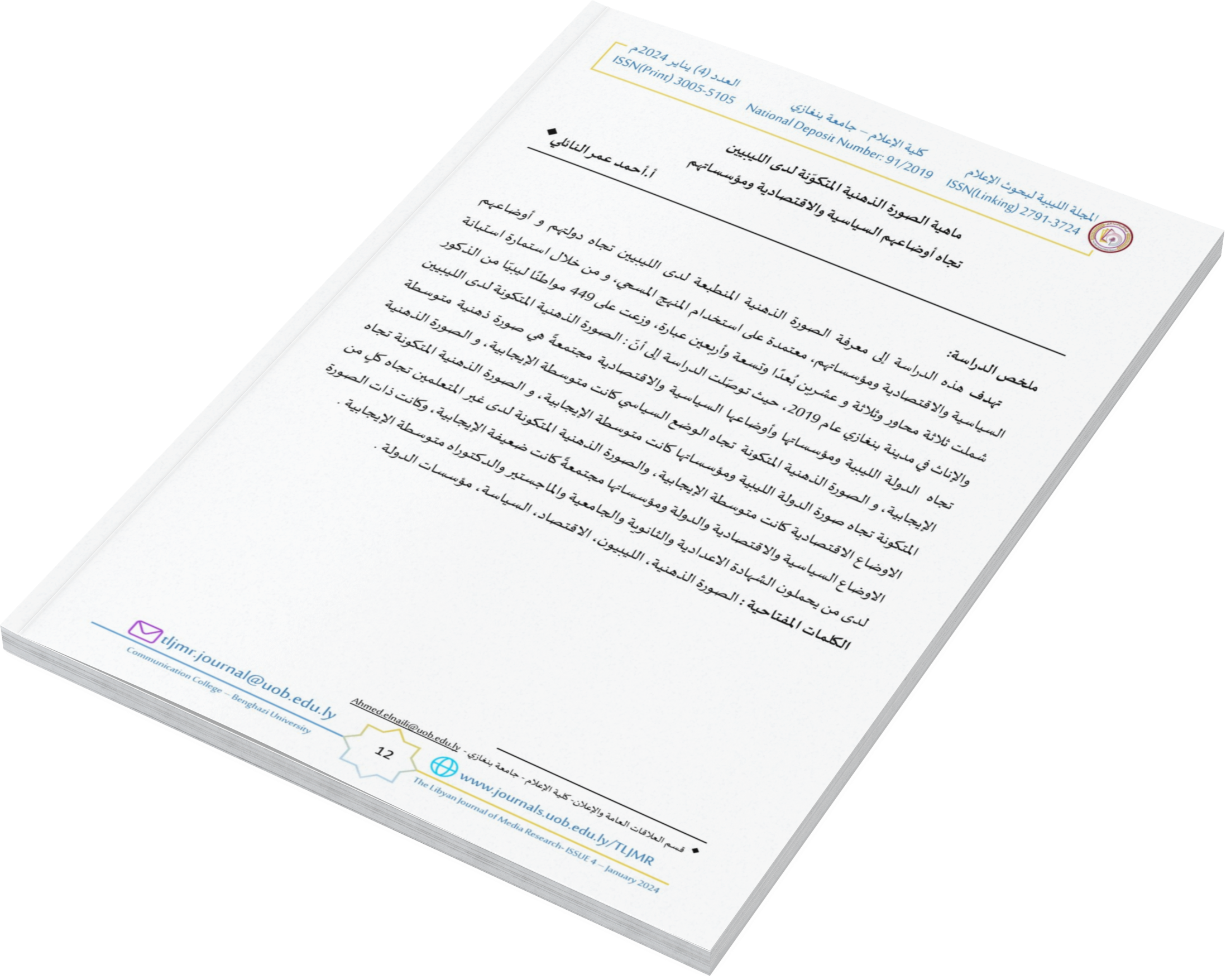The mental image that Libyans have regarding their political and economic conditions and institutions
DOI:
https://doi.org/10.37376/tljmr.vi4.4638Keywords:
الصورة الذهنية، الليبيون ، الاقتصاد ، السياسة ، مؤسسات الدولة .Abstract
This study aims to conclude the mental image that Libyans have regarding their country, their political and economic conditions, and their institutions. The questionnaire form included 49 questions and was distributed to 449 Libyan male and female citizens in the city of Benghazi in 2019.
The study reached the following results:
- The mental image that Libyans have of the Libyan state, its institutions, and its political and economic conditions taken together is a positive mental image on average.
- The mental image formed regarding the political situation was positive on average.
- The mental image formed regarding the image of the Libyan state and its institutions was positive on average.
- The mental image formed regarding the economic conditions was positive on average.
- The mental image formed by the uneducated towards both the political and economic conditions and the state and its institutions together was weakly positive. The mental image of the educated was average positive.
Downloads
References
الهوامش والمراجع
-Rubin, Rebecca. B. & Rubin, Alan, M. Others. "Communication Research: Strategies and Sources." 7th Edition. Australia: Wadsworth Cengage learning, 2010, p. 218-219.
- قام الباحث بعرض استمارة الدراسة الميدانية علي مجموعة من الأساتذة المحكمين وهم :
د/ إسلام أحمد أحمد عثمان أستاذ الإعلام بقسم العلاقات العامة بكلية الإعلام جامعة بني سويف/ مصر.
د/ مسعود التايب أستاذ الإعلام بقسم الإعلام جامعة الزاوية .
د/ سعيد شناني أستاذ الإعلام بقسم الإعلام كلية الآداب جامعة عمر المختار.
د/ فرحات خليل الفاخري أستاذ الإعلام بقسم العلاقات العامة بكلية الإعلام جامعة بنغازي.
د/ محمد الأصفر أستاذ الإعلام بقسم الإعلام كلية الآداب جامعة الزيتونة.
(3) McCluskey , Michael and Mie Kim , Young. " Moderatism or Polarization? Representation of Advocacy Groups' Ideology in Newspapers " ,Journalism & Mass Communication Quarterly ,(VOL . 89, NO.4, 2012).
- ميرال مصطفى, علاقة برامج الرأي التلفزيونية بالاستقطاب السياسي لدى الجمهور المصري, مجلة البحوث الاعلامية, (العدد50, أكتوبر/ 2018).
- سارة طلعت عباس, الاستقطاب السياسي في معالجة الصحف والتلفزيون لأحداث العنف السياسي بمصر ودوره في تشكيل اتجاهات المراهقين نحوها "رسالة دكتوراه غير منشورة ) القاهرة: جامعة عين شمس – معهد الدراسات العليا للطفولة – قسم الإعلام(2016
- سازان سامان عبدالمجيد وعبد الكريم علي الدبيسي, تقييم النخبة لدور وسائل الإعلام العراقية في مواجهة الطائفية, دورية إعلام الشرق الأوسط, جامعة ولاية جورجيا, الولايات المتحدة الأمريكية, العدد الثاني عشر خريف 2016, ص ص21-38.
-Philips Davison (1983). The third-Person Effectin Communication Public Openion Quarterly, Spring, vol.47, PP.1-15.
- Perloff,R.M (1993).Third Person Effects Research 1983-1992,Op.Cit.P.173.
- Innes, J.M.; Zeitz, H.,(1988)“The public's view of the impact of the mass media: A test of the "third-person" effect". European Journal of Social Psychology. Vol 18. p. 461.
- Gunther, C. Albert (1995) Overrating the X-Rating: The Third Person Perception and Support for Cencorship of Pornography. Journal of Communication. Vol. 45. No. 1. PP. 27 – 38.
-Salween M. (1998). “Perception of Media Influnce and Support of Censorship. The Third Person effect in the 1996 persidential Election “Communication Research. Vol. 25. P. 261.
-Price V., Huang, L. & Teuksbury, D. (1997). “Third.person Effect of News Coverage: Orientation Toward Media. Journalism & Communication Quarterly, vol. 74, PP. 525-540.
-Philips Davison ,op.cit, p6.
- سارة طلعت عباس,مرجع سابق, ص71.
-https://alghad.com/%D8%A7%D9%84 تم الاطلاع 24-5-2021
-https://www.alroeya.com/119-86/2195719 تم الاطلاع 24-5- 2021 الإعلام-الليبي-وخطاب-الكراهية
المراجع
- سارة طلعت عباس, الاستقطاب السياسي في معالجة الصحف والتلفزيون لأحداث العنف السياسي بمصر ودوره في تشكيل اتجاهات المراهقين نحوها “رسالة دكتوراه غير منشورة ) القاهرة: جامعة عين شمس – معهد الدراسات العليا للطفولة – قسم الإعلام(2016.
- سازان سامان عبدالمجيد وعبد الكريم علي الدبيسي, تقييم النخبة لدور وسائل الإعلام العراقية في مواجهة الطائفية, دورية إعلام الشرق الأوسط, جامعة ولاية جورجيا, الولايات المتحدة الأمريكية, العدد الثاني عشر خريف 2016.
- ميرال مصطفى, علاقة برامج الرأي التلفزيونية بالاستقطاب السياسي لدى الجمهور المصري, مجلة البحوث الإعلامية, ( العدد50, أكتوبر/ 2018).
- Gunther, C.Albert (1995)Overrating the X-Rating:The Third Person Perception & Support for Cencorship of Pornography. Journal of Communication.Vol.45.No.1.
- Innes, J.M.; Zeitz, H.,) 1988(“The public's view of the impact of the mass media: A test of the "third-person" effect". European Journal of Social Psychology. Vol 18.
- McCluskey , Michael and Mie Kim , Young. " Moderatism or Polarization? Representation of Advocacy Groups' Ideology in Newspapers " ,Journalism & Mass Communication Quarterly , ( VOL . 89, NO.4, 2012).
- Philips Davison (1983). The third-Person Effectin Communication Public Openion Quarterly, Spring, vol.47.
- Price V., Huang, L. & Teuksbury, D. (1997). “Third.person Effect of News Coverage: Orientation Toward Media. Journalism & Communication Quarterly, vol. 74.
- Rubin, Rebecca. B. & Rubin, Alan, M. Others. "Communication Research: Strategies & Sources." 7th Edition. Australia: Wadsworth Cengage learning, 2010.
- Salween M. (1998). “Perception of Media Influnce and Support of Censorship. The Third Person effect in the 1996 persidential Election “Communication Research. Vol. 25.

Downloads
Published
How to Cite
Issue
Section
License
Copyright (c) 2024 The Libyan Journal of Media Research

This work is licensed under a Creative Commons Attribution-NonCommercial-NoDerivatives 4.0 International License.








